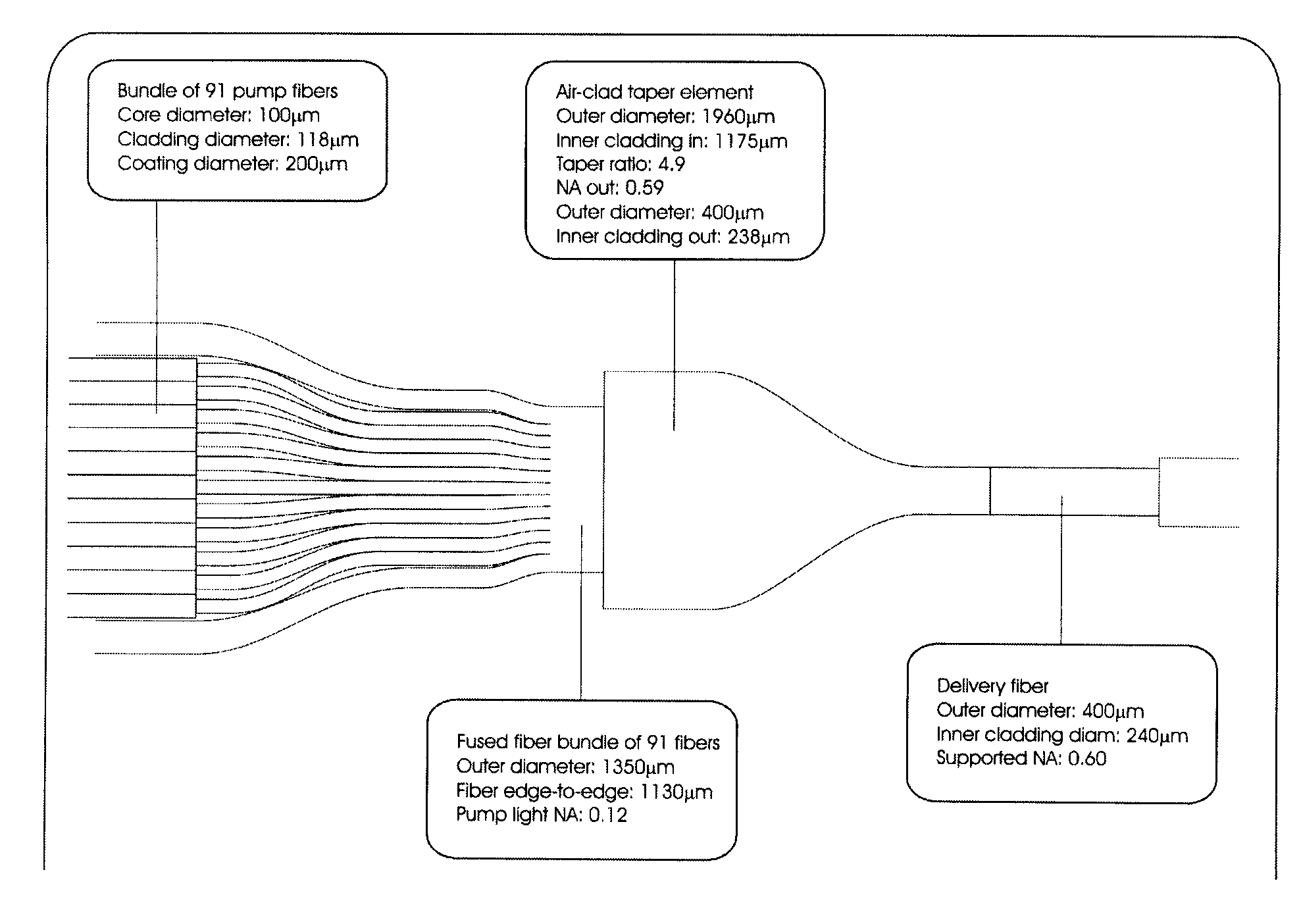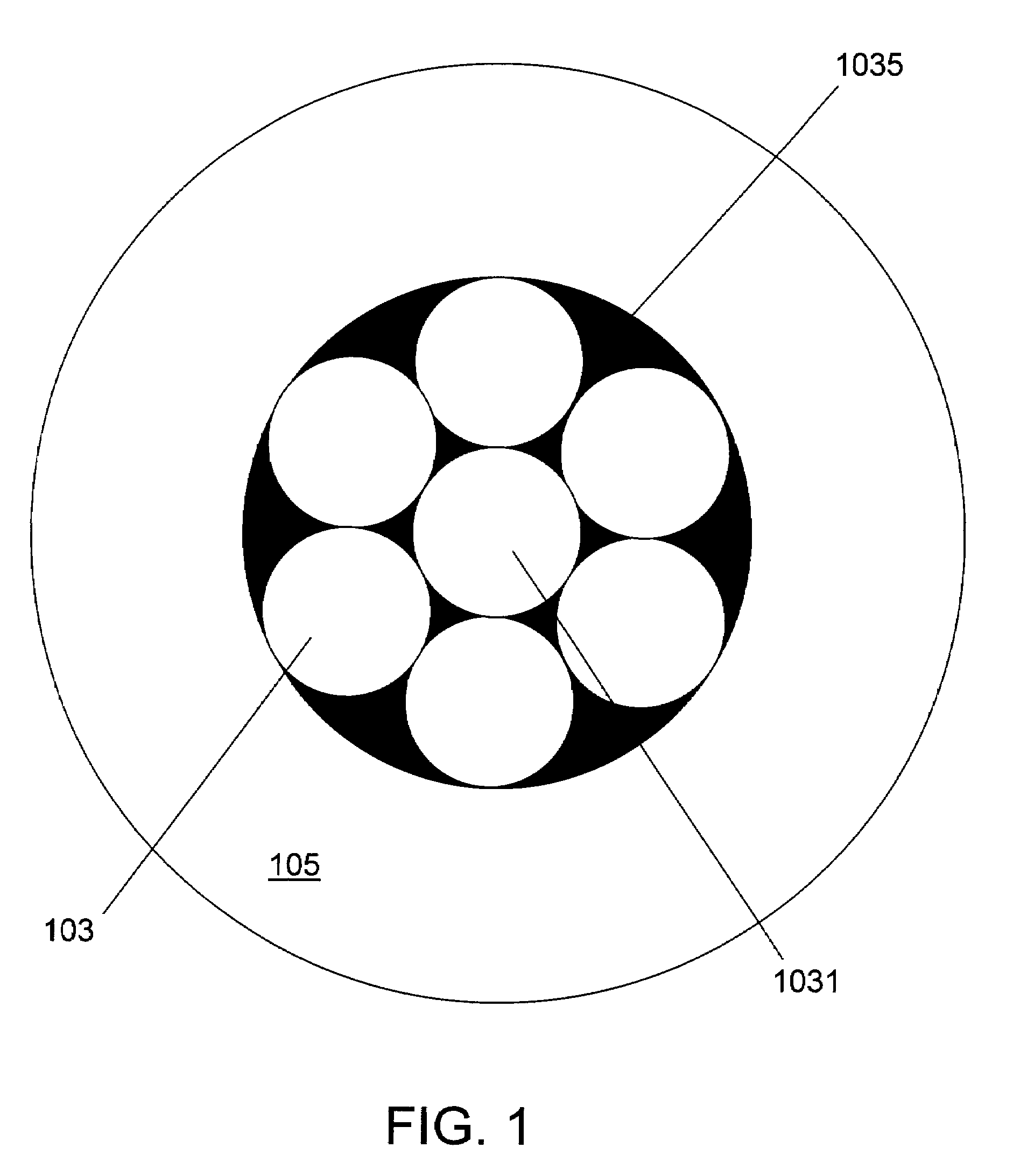Optical coupler, a method of its fabrication and use
a technology of optical couplers and optical couplings, applied in the field of optical couplers, can solve the problems of reducing the diameter of the mode field of the signal fiber, the disadvantages of the coupler, and the difficulty of handling, and achieve the effect of low-loss optical coupling
- Summary
- Abstract
- Description
- Claims
- Application Information
AI Technical Summary
Benefits of technology
Problems solved by technology
Method used
Image
Examples
example 1
An Optical Coupler for Providing Pump Light
[0159]FIG. 7 shows an embodiment of an optical coupler according to the invention, FIG. 7a schematically illustrating the interface between the input and output sections and FIGS. 7b-7d showing photomicrographs of different cross sections of an implemented device along the length of the coupler.
[0160]This section describes the realization of a pump combiner with 7 pump fibers. The combiner is realized using a Vytran GPX-3100 for tapering and fusing, while splicing is performed on a Vytran LDS-1250. On both machines a F100-12525-N10 tungsten filament is used. Cleaving is performed on a Vytran LDC-200. All Vytran apparatuses are from Vytran Corp. (Morganville, N.J., USA).
[0161]Seven pump fibers of 0.5 m length were prepared with 6 cm uncoated ends. Pump fibers with 105 μm core, 118 μm outer diameter and 200 μm coating diameter are used. The pump fibers support up to 0.22 NA. Such fibers can e.g. be obtained from LG Optics (Light Guide Optics ...
example 2
An Optical Coupler with Signal Feed Through
[0177]The present example deals with an optical coupler suitable for use in a fiber amplifier, wherein the input section comprises a centrally located signal fiber surrounded by a number of pump fibers and wherein the tapered output section of the optical coupler comprises a centrally located region adapted for guiding the signal light in a single mode and surrounded by a region for guiding the pump light.
[0178]In prior art tapered fiber bundle couplers, the same fibers constitute the cross section at every point from input to tapered output. In the approach described here a single-mode fiber and a number of pump fibers are fused together in a bundle and subsequently cleaved without tapering to create an output face of an input section of the coupler. The fused bundle is then spliced to the output section in the form of a double clad fiber, which is cleaved (to form an input end face) and tapered. The other end of the output section of the ...
example 3
An All-Solid Signal Feed-Through Fiber
[0190]This aspect relates also to the published PCT-application WO 2005 / 091029 and can be used in connection with but is NOT restricted to use in the above described ‘two-part’ optical coupler (but can be used in couplers based on a tapered bundle of fibers).
[0191]The idea is to substitute air-holes in the micro-structured feed-through fiber with solid glass inclusions having lower refractive index than the base material (e.g. silica). This eliminates the problem of holes in the feed-through fiber collapsing when this is incorporated into the fused bundle, tapered and spliced. Collapsing of holes is a major concern since the fusing of pump and signal fibers into a round bundle require excessive heat.
[0192]In its broadest aspect, the idea thus covers an optical coupler for coupling light from at least two input fibers into one output fiber, the optical coupler comprising a microstructured feed-through fiber with solid glass inclusions having lowe...
PUM
| Property | Measurement | Unit |
|---|---|---|
| length | aaaaa | aaaaa |
| tapering length | aaaaa | aaaaa |
| diameter | aaaaa | aaaaa |
Abstract
Description
Claims
Application Information
 Login to View More
Login to View More - R&D
- Intellectual Property
- Life Sciences
- Materials
- Tech Scout
- Unparalleled Data Quality
- Higher Quality Content
- 60% Fewer Hallucinations
Browse by: Latest US Patents, China's latest patents, Technical Efficacy Thesaurus, Application Domain, Technology Topic, Popular Technical Reports.
© 2025 PatSnap. All rights reserved.Legal|Privacy policy|Modern Slavery Act Transparency Statement|Sitemap|About US| Contact US: help@patsnap.com



